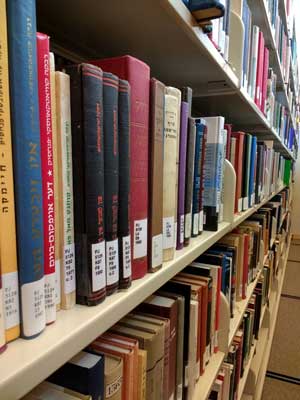I’ve been working at the Museum Library for a few weeks now; I’ve learned how to process books for their collection and make records through copy-cataloging. And, I’ve also learned how to measure rare books for Kasebox enclosures (which are custom made, high quality, archival boxes for rare and delicate materials), and how to process both rare items and Library donations.
It hasn’t even been a month, and I feel like I’ve learned so much. I’m also settling into my neighborhood well – I’ve found a few good restaurants and bought some new plants!
The David and Fela Shapell Family Collections, Conservation, and Research Center
The United States Holocaust Memorial Museum has an off-site research center called the David and Fela Shapell Family Collections, Conservation, and Research Center (or, as we call it, the Shapell Center!). Patrons will be able to come and utilize a whole myriad of materials for their research.
The Shapell Center is also a storage facility for a large percentage of our physical artifacts, archive collections, and books. The plan is to move every second copy of a book title to the Shapell Center – pulling books will help alleviate the tension in our shelves at the Library, and give us the shelf space for new titles.
Unfortunately, shelving units haven’t been built into the Library Vault at the Shapell Center yet. The vault space resembles an unfurnished warehouse – full of bins that are full of books. When it comes time to install the shelves, all of those bins will be moved. In that sense, it doesn’t seem logical to ship even more bins of books to the Shapell Center.

Books at the United States Holocaust Memorial Museum Library
Too Many Books?
But, the shelves at the Library are stuffed to the breaking point, and they will only get more stuffed. We are getting new books everyday, and those books need to be prepared for circulation.
As part of the Library’s collection policy, librarians do not weed books; the Museum Library is an archival library, and its collection serves as a record for the Holocaust. In order to preserve the authenticity of that record, librarians rarely remove an item from the catalog. So, we sometimes have up to three or four copies of one title. And those copies are taking up space on the shelf.
Is it better if we pack up books to ship off, when they will only have to be moved again? Or, is it better if we just leave the books where they are, even though the shelves are crowded beyond belief? And, knowing all of that, does it even make sense for me to keep processing books to put on those crowded shelves?
(Yes, because if I didn’t, then the acquisitions office would be overflowing with books waiting to go out on the floor. Even so, I can’t help but feel complicit, as I continue to prepare fresh books for circulation. And, of course, all of this is temporary. Once the Library Vault is fully furnished, our books will have plenty of space – both in the Library and the Shapell Center.)
Managing a Library Collection
One of the new librarians is now responsible for restarting the binning process. There are five book carts completely full of books that won’t fit on the shelf, and the Library staff has decided that it’s time to start pulling second copies.
The librarian will find the most fraught sections of the collection and begin packing up books to ship to the Shapell Center. However, we won’t send the bins out just yet. We’re going to stack them up in the hallway until the time comes to move them.
Every item in our collection has a digital record in our catalog; when we move anything from the Museum to the Shapell Center, we have to update its record to reflect its new home. This way, everyone will know where it is.
Furthermore, some items might be in a specific location within the Shapell Center. If it’s oversized or rare, for example, it will have a different location than other library materials. So, part of the process includes updating the locations and item types for the Shapell Center within our digital catalog.
I am honestly looking forward to helping out with the process. It’s a great opportunity to get some hands-on experience with collections management. Quite literally hands-on, as my hands will soon be putting books in those bins.
Invaluable Library Experience
This has also provided me with keen insight into the inner machinations of a library. A few of my professors have said that, until we are working in a library, it’s hard to know what it will truly be like.
That’s why I value the experiences that I’m getting here in the Museum Library. They validate what I’ve learned about library and collections management. I’m taking a course next semester that focuses specifically on collections development, and I can’t wait to learn even more.
by Ruby Williamson
